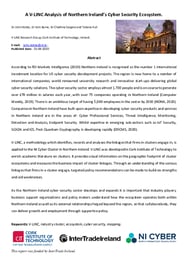Published: 1 September 2020
Introduction
This paper represents a collaboration between the Cork Institute of Technology and NI Cyber who partnered to apply V-LINC to the cyber security specialisation in Northern Ireland.
The cyber security industry in Northern Ireland has been growing steadily over the past decade, it presently employs nearly 1,700 people. It is on course to generate more than £70m in salaries each year, according to Máire O’Neill, Professor at Queen’s University Belfast speaking at the 9th World Cyber Security Summit. “With the unrelenting pace of digital adoption, the role of cyber security has never been more significant. Its importance to our lives and livelihoods is increasing exponentially and those with the skillsets to contribute to this vital societal need will always have a place in the new economy.”
In 2017 Centre for Secure Information Technologies (CSIT), kick started, what would in time become NI Cyber, when they brought together sixteen companies, a mixture of cyber start-ups SMEs and large firms, for a design thinking innovation workshop to see if there were opportunities for collaboration around addressing the skills gap through training in Northern Ireland and connecting the R&D ecosystem. The group connected with the Open Web Application Security Project (OWASP) and Information Systems Audit and Control Association ISACA to collaborate, and more cyber focused firms began to participate. In summer 2019, funding was sought for a Programme Manager through Invest Northern Ireland’s Collaborative Growth Programme – Phase 1. This support is for SME-led networks requiring facilitation support to scope out innovative collaborative projects with the potential to increase business competitiveness.
In late 2019, funding was allocated to NI Cyber and they have started in earnest to develop their network, with the number of participating organisations increasing to 40. The group are now looking to develop a longer-term strategic perspective, as they seek to develop into a European Style Cluster organisation – and are looking at core funding models from a Phase 2 application to Invest Northern Ireland’s – Collaborative Growth Programme or perhaps dedicated cluster funding from the Department of Economy, Northern Ireland – or a combination of both. At this stage of NI Cyber’s development, participants and policy makers must understand how the ecosystem operates both within Northern Ireland as well as its external relationships forged beyond the region, so that collaboratively, they can deliver growth and employment through supportive policy.
The paper begins with an explanation of V-LINC, a methodology which records, categorizes and measures the business importance of linkages that cluster firms participate in, along with the facility to show linkages on geographic maps of appropriate scale. Linkages (see Figure 1 on page 3 of report) between firms and other organisations are at the heart of how clusters function. Linkages are defined (Hobbs, 2010; p 221) as “relationships that enable exchange of goods, services, personnel, information, ideas, expertise, grants and other supports to business that occur between two or more parties, over a sustained time period.” Next, the paper comments on the scale of the cyber security industry in Northern Ireland, then reviews findings from V-LINC analysis on the linkages of a sample of cyber firms in Northern Ireland. The analysis includes: the distribution of linkages by category, by geographic scope, and by their business impact as recorded by company employees who engage in the linkages. V-LINC maps illustrate the linkages at different geographic scopes. Arising from the analysis a judgement is made about the extent of cluster activity in the cyber security industry in Northern Ireland.
The paper closes with recommendations on how to strengthen and support the NI Cyber Cluster in Northern Ireland.
 Click here to download the full report: A V-LINC Analysis of Northern Ireland’s Cyber Security Ecosystem
Click here to download the full report: A V-LINC Analysis of Northern Ireland’s Cyber Security Ecosystem
